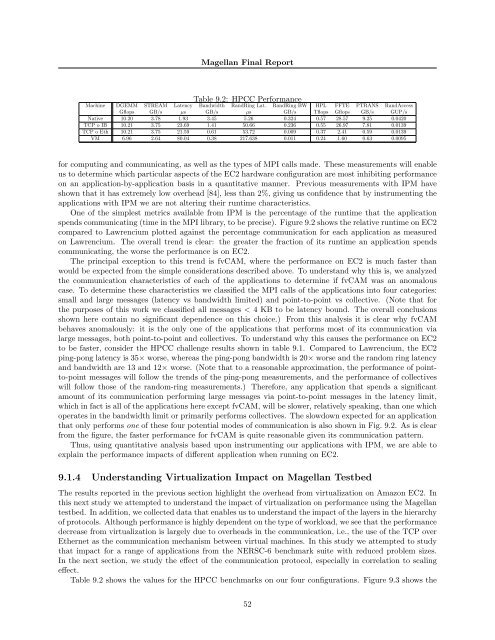Magellan Final Report - Office of Science - U.S. Department of Energy
Magellan Final Report - Office of Science - U.S. Department of Energy
Magellan Final Report - Office of Science - U.S. Department of Energy
Create successful ePaper yourself
Turn your PDF publications into a flip-book with our unique Google optimized e-Paper software.
<strong>Magellan</strong> <strong>Final</strong> <strong>Report</strong><br />
Table 9.2: HPCC Performance<br />
Machine DGEMM STREAM Latency Bandwidth RandRing Lat. RandRing BW HPL FFTE PTRANS RandAccess<br />
Gflops GB/s µs GB/s µs GB/s Tflops Gflops GB/s GUP/s<br />
Native 10.20 3.78 1.93 3.45 5.26 0.324 0.57 28.57 9.25 0.0420<br />
TCP o IB 10.21 3.75 23.69 1.41 50.66 0.236 0.55 26.97 7.81 0.0139<br />
TCP o Eth 10.21 3.75 21.59 0.61 53.72 0.009 0.37 2.41 0.59 0.0139<br />
VM 6.96 2.64 80.04 0.38 217.638 0.011 0.24 1.60 0.63 0.0095<br />
for computing and communicating, as well as the types <strong>of</strong> MPI calls made. These measurements will enable<br />
us to determine which particular aspects <strong>of</strong> the EC2 hardware configuration are most inhibiting performance<br />
on an application-by-application basis in a quantitative manner. Previous measurements with IPM have<br />
shown that it has extremely low overhead [84], less than 2%, giving us confidence that by instrumenting the<br />
applications with IPM we are not altering their runtime characteristics.<br />
One <strong>of</strong> the simplest metrics available from IPM is the percentage <strong>of</strong> the runtime that the application<br />
spends communicating (time in the MPI library, to be precise). Figure 9.2 shows the relative runtime on EC2<br />
compared to Lawrencium plotted against the percentage communication for each application as measured<br />
on Lawrencium. The overall trend is clear: the greater the fraction <strong>of</strong> its runtime an application spends<br />
communicating, the worse the performance is on EC2.<br />
The principal exception to this trend is fvCAM, where the performance on EC2 is much faster than<br />
would be expected from the simple considerations described above. To understand why this is, we analyzed<br />
the communication characteristics <strong>of</strong> each <strong>of</strong> the applications to determine if fvCAM was an anomalous<br />
case. To determine these characteristics we classified the MPI calls <strong>of</strong> the applications into four categories:<br />
small and large messages (latency vs bandwidth limited) and point-to-point vs collective. (Note that for<br />
the purposes <strong>of</strong> this work we classified all messages < 4 KB to be latency bound. The overall conclusions<br />
shown here contain no significant dependence on this choice.) From this analysis it is clear why fvCAM<br />
behaves anomalously: it is the only one <strong>of</strong> the applications that performs most <strong>of</strong> its communication via<br />
large messages, both point-to-point and collectives. To understand why this causes the performance on EC2<br />
to be faster, consider the HPCC challenge results shown in table 9.1. Compared to Lawrencium, the EC2<br />
ping-pong latency is 35× worse, whereas the ping-pong bandwidth is 20× worse and the random ring latency<br />
and bandwidth are 13 and 12× worse. (Note that to a reasonable approximation, the performance <strong>of</strong> pointto-point<br />
messages will follow the trends <strong>of</strong> the ping-pong measurements, and the performance <strong>of</strong> collectives<br />
will follow those <strong>of</strong> the random-ring measurements.) Therefore, any application that spends a significant<br />
amount <strong>of</strong> its communication performing large messages via point-to-point messages in the latency limit,<br />
which in fact is all <strong>of</strong> the applications here except fvCAM, will be slower, relatively speaking, than one which<br />
operates in the bandwidth limit or primarily performs collectives. The slowdown expected for an application<br />
that only performs one <strong>of</strong> these four potential modes <strong>of</strong> communication is also shown in Fig. 9.2. As is clear<br />
from the figure, the faster performance for fvCAM is quite reasonable given its communication pattern.<br />
Thus, using quantitative analysis based upon instrumenting our applications with IPM, we are able to<br />
explain the performance impacts <strong>of</strong> different application when running on EC2.<br />
9.1.4 Understanding Virtualization Impact on <strong>Magellan</strong> Testbed<br />
The results reported in the previous section highlight the overhead from virtualization on Amazon EC2. In<br />
this next study we attempted to understand the impact <strong>of</strong> virtualization on performance using the <strong>Magellan</strong><br />
testbed. In addition, we collected data that enables us to understand the impact <strong>of</strong> the layers in the hierarchy<br />
<strong>of</strong> protocols. Although performance is highly dependent on the type <strong>of</strong> workload, we see that the performance<br />
decrease from virtualization is largely due to overheads in the communication, i.e., the use <strong>of</strong> the TCP over<br />
Ethernet as the communication mechanism between virtual machines. In this study we attempted to study<br />
that impact for a range <strong>of</strong> applications from the NERSC-6 benchmark suite with reduced problem sizes.<br />
In the next section, we study the effect <strong>of</strong> the communication protocol, especially in correlation to scaling<br />
effect.<br />
Table 9.2 shows the values for the HPCC benchmarks on our four configurations. Figure 9.3 shows the<br />
52

















